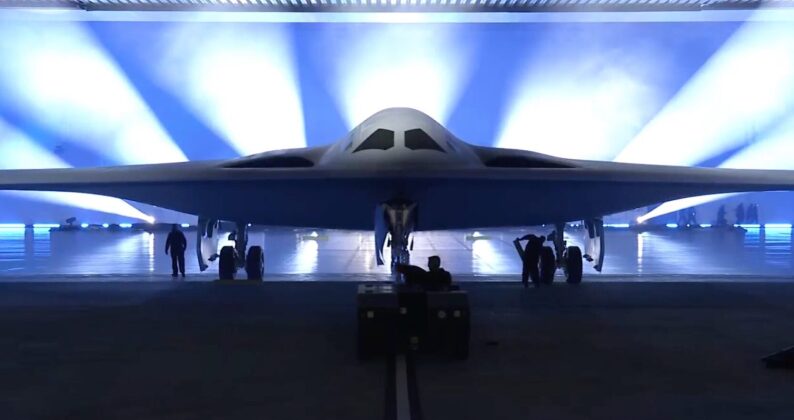News
B-21 Raider vs. B-2 Spirit: Which of America’s Strategic Stealth Bombers Has the Advantage?

The unveiling of the Northrop Grumman B-21 Raider intercontinental range strategic bomber on November 2 marks a milestone in the history of the U.S. Air Force, and for the strike capabilities of the NATO alliance as a whole, as the much anticipated aircraft is set to revolutionise American strike capabilities for both strategic and tactical missions across the world. The aircraft’s unveiling has prompted widespread comparisons of its capabilities with existing bomber classes, including the American B-2, B-1B and B-52H and the Russian Tu-160 and Tu-95 which were all also designed for very long range nuclear strikes. Of all of them, however, the B-21 is most comparable in its design and capabilities to the B-2 Spirit which was also developed by Northrop Grumman and unveiled 34 years prior in 1988. The two aircraft are the only manned flying wing designs to have been publicly unveiled worldwide, and although they are restricted to subsonic speeds they are far less reliant than all other bomber classes on launching long range cruise and ballistic missiles. Both were designed to be able to viably deliver gravity bombs against well defended targets while flying deep inside enemy airspace. This kind of capability remains highly valued, since not only does dropping bombs allow for significantly larger payloads to be delivered, and usually at a much lower cost, but it also allows for the employment of munitions with much larger warheads including penetrative rounds such as the GBU-57 which can threaten fortified targets in a way that air launched missiles cannot.
While the B-2, like all post Second World War bomber classes, was designed with penetration of Soviet airspace in mind, the rapid shift in the global balance of power in the 30 years between the two programs has meant that the B-21 was designed primarily to tackle Chinese air defences. This reflects China’s emergence as the world’s second largest military spender, which overtook the U.S. in spending on defence acquisitions in 2020, as well as its leadership in high tech and innovation leaving Russia, which faced a sharp post-Soviet decline from the early 1990s, as a far less pressing military challenge. The B-2 was designed at a time when many potential U.S. adversaries fielded large and sophisticated air forces, from Libya, Iraq and Syria to the Warsaw Pact countries, North Korea and the USSR itself, the B-21 was developed at a time when China was the only one in the world fielding fighter aircraft from the same generation as the United States and competing on a peer level. The Warsaw Pact’s disintegration and absorption into NATO, Western attacks on Libya, Iraq and Syria, and pressure on Russia not to arm North Korea, combined with a cutting of Russian defence spending and R&D to a very small fraction of its Soviet era size, means cutting edge fighters – fourth generation in the B-2’s era and fifth generation in the B-21’s – are far fewer and further between in the era of the newer bomber. With Russia today around 20 years behind where the Soviet Union would have been in terms of fielding next generation fighters, the threat the B-21 faces from enemy fighters outside China is far less than the B-2 would have in its era.

In terms of design the B-21 is very much an evolution of the B-2, loosely comparable to the relationship between the F-18E/F Super Hornet and F-18 Hornet fighters, or that between the F-18 and the F-5, with a strong resemblance between the two going far beyond their common flying wing design. The B-21 is nevertheless noticeably smaller and lighter, which is thought to be a result of efforts to make it less costly to maintain and cheaper to build, but may also be related to its stealth capabilities. Despite being older, the B-2 had a much higher endurance and weapons payload, which proved particularly important when it emerged that the aircraft could not be based outside U.S. territory due to their unique maintenance requirements. The B-21 by contrast has a more limited range than any other American bomber class, but is expected to be able to operate from bases abroad as the B-52 and B-1B currently can. The newer bomber is also considerably more versatile, and was designed to be able to collect information, fire defensive air to air weapons and possibly serve in a limited function as a command and control aircraft. Likely the most significant advantage of the B-21 will be its maintainability and sortie rate, with the B-2 having been notorious for its need for 60 man hours of maintenance on the ground for every flight hour and its extreme cost of over $150,000 per hour in the air. The B-21 by contrast is thought to have been more maintainable, but also less fragile than the B-2. Where issues and cost overruns with the B-2 meant only 20 were ever built, with a prototype also converted for service, the B-21 is expected to see over 100, and possibly over 200, built for the U.S. Air Force alone with exports potentially being considered.

The B-21’s shorter range means it will likely be based abroad much more frequently, or else in forward positioned American territories such as Guam and Wake Island, as it lacks the endurance to strike targets across the world from bases on the U.S. mainland. This could leave the aircraft more vulnerable as adversary strike capabilities against key overseas bases continue to expand rapidly, or else place a greater strain on the Air Force’s tanker fleet to provide aerial refuelling. The fact that the aircraft carry less ordinance may not have a significant impact on most missions, with the payload at well over half that of the B-2 still sufficient to saturate most targets. The B-21’s much larger numbers mean it will pose a significantly greater challenge to enemy defences, although the fact that China’s territory is far smaller than that of the Soviet Union means defences are likely to be much more concentrated in the event of war. Although programs to develop manned or unmanned wingmen to escort the B-21 were previously proposed, hurdles faced in development led to their cancellation meaning the bomber will need to be able to enter enemy territory unescorted.

While the B-2 was a totally unique asset in its time, flying wing stealth aircraft are today fielded by China, the United States and Iran and have been successfully combat tested by the latter two, with a Chinese rival to the B-21 the H-20 expected to enter service at around the same time in 2026-28. Perhaps the greatest advantage the B-2 had in its era is that it was developed at a time when stealth aircraft were practically non existent, while the B-21 will enter service around 40 years after the first stealth fighter at a time when counter stealth technologies, ranging from Chinese quantum radars to Russian multi band integrated radar networks, have been invested in very heavily for decades to confront a wide range of threats. Although the B-21 will be a much more survivable aircraft with significantly superior stealth capabilities, it will fly in an age where stealth has become the norm for new Chinese and American combat aircraft and air defence networks are far better prepared to counter it.












